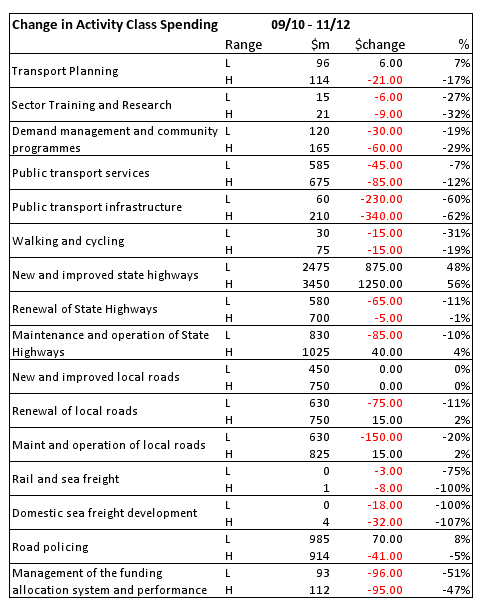The Government Policy Statement (GPS) on transport guides central and local transport planning throughout the country, so it’s an important document.
The Government has announced changes to the GPS. The new GPS has not been released yet, but the Minister of Transport has signalled his intentions with this document, which discusses the amendments that are about to be made in general terms, and also reallocates funding across different categories.
I’ve crunched the numbers, and the results are somewhat surprising.
The Minister’s reasons for changing the GPS are:
- to reflect the government’s priority of investment in transport infrastructure for economic growth
- to reflect the modal choices that are realistically available to New Zealanders
 “Transport infrastructure for economic growth” is code for building more roads, even though there is very strong evidence that the benefit cost ratios used for roading projects are fundamentally flawed. (More on this in an upcoming post). Reflecting “modal choices that are realistically available to New Zealanders” is code for reducing spending on public transport.
The upshot is that almost $1bn will be diverted from other categories into new state highways, in spite of the fact that none of the proposed “highways of national significance” stack up economically. The current GPS is here.
By comparing the two documents, this analysis shows the seismic shift in funding to new state highways:

Note that spending by activity class is expressed as a range, not a single number. So, for example, funding for public transport services will be cut by 45 – 85m (or 7 – 12%) over the next three years.
What is also surprising is that the maintenance and operation of local roads could take a hit of $150m over the next 3 years, putting more pressure on local council rates.
The Minister is diverting as much money as possible into the “New and Improved State Highway” category. Even though it is claimed that building more highways will boost economic growth, there is no supporting evidence that this is the case.Â
I can’t help feeling the Minister of Transport is rushing in to this. In the next post, I’ll explain why putting all your eggs into new highways could be a big mistake.

5 thoughts on “Government To Reduce Local Road Funding By Up To $225m”
I think perhaps one reason for the big drop in public transport funding is that Wellington’s rail upgrades have been removed from the transport fund and will now come directly from the Crown. Perhaps future rail upgrades for Auckland will do the same. I’m not sure why this is the case, but perhaps to appease the trucking lobby who hate the thought of any petrol taxes being spent on rail/public transport.
So yeah, maybe reductions in public transport infrastructure won’t be quite so significant. But overall this is still a stupid strategy, quite funny if petrol’s $4 a litre in a few years time.
Are the proposed reductions for PT and local roads the reason Rodney Hide is proposing legislation to cap rates increases?
Without being able to increase rates to access the belated increase in NLTP funding to cover the increases in the costs of road works due to the 30%increas in the costs of construction materials and machinery since 2000.
That means they must continue deferring essential maintenance in the full knowledge that this is going to cost much more in the medium term than it will save in the short term.
If regional councils can’t increase their rates by more than the rate of inflation without a referendum then they will have to reduce PT infrastructure spending to cover increased PT operating costs. Since the NLTP matches this funding it will never be able to spend all the money it had been planning for in early NLTP forecasts.
Oops…the middle two para’s refer to district councils.
There is huge hysteria about rates in recent years, with councils fairly understandably being utterly terrified of anything that might require them to raise rates. I think Rodney Hide’s “cap” is pretty pointless really, as more recent local government elections have shown us that most people don’t think about local government at any other point than when they open their rates bill.
Personally I think it’s time councils looked at other ways to raise money. A share of GST perhaps?
Marlborough D.C.’s LTCCP discussion document proposes rates increases 40% above inflation over the next ten years because:
1)$500,000 increased costs of maintaining roads attributable to higher fuel and bitumen costs and safety improvements.
2)$880,000 increased water supply and sewerage costs due to additional debt servicing costs for expansion/upgrades. increased depreciation costs arising from asset revaluation and increased power costs.
3) $760,000 Increased refuse collection costs and new kerbside recycling scheme.
I suspect that asset revaluation means they’ve discovered widespread problems with leaky water mains and will have to accelerate their replacement program.
The burst of infrastructure building during the baby boom created a period of several decades of minimal maintenance was needed and the abrupt end of the baby boom and economic boom meant much of that infrastructure didn’t reach design capacity till a decade or two later than the planning had assumed in the ’50s and ’60s. It’s those lucky decades from the mid-70s to the mid-90s that ratepayers prefer to remember rather than the expensive decades before then.
A share of GST seems like a good idea but in the USA it has been applied to spending on roads which in my opinion is a retrograde step.